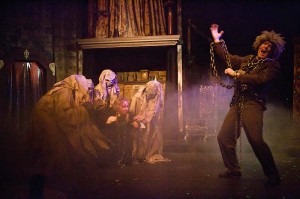Lenses for Theatrical Photgraphy
More and more people are asking about the right lenses for photographing theatre, so here are my 2 cents. There are so many choices but my general advice is this: Get the fastest glass you can afford–if you do this kind of photography a lot, it’s worth it. By “fastest,” I mean the largest possible maximum aperture. In terms of flexibility, something like a 24-70mm with a constant f2.8 is great, but you’ll find with some theatre productions, you will still have to bump your ISO very high, because they can be dark. Very dark. Here is an example of something I shot at ISO 3200, f2.8 at 1/30th . A very challenging production because scenes like this one were so dark and obscured with fog.
Had I shot the above picture with a lens that had an aperture range of something like f3.5-5.6, I would have to bring my shutter speed down to something unacceptably low; with all actors’ movement, a blurry picture is all but guaranteed.
Another thing to think about is your focal length coverage. If the theater is big with a high stage, you may find yourself backing up 5-10 rows and shooting with long glass. If it’s small and intimate, you might find yourself right up against the stage and shooting wide to medium. For the most flexibility, a 24-70mm f2.8 will give you great coverage, but if you have the means, I would suggest adding something like a 70-200mm f2.8 so you can get close-ups of actors and their expressions. You really have to think about covering a show with everything from wide shots that showcase the scope of the set, all the way to tight, emotionally evocative expressions on actors’ faces.
Then, there’s the prime lens school of thought. I personally love using primes. I shot this entire production with a 50mm f1.4: http://www.mikepadua.com/Theater/ihatehamlet/12858869_8FhdcP#928216556_YqvWr. However, I had a large area to move about in front of the stage, which allowed me to “zoom” in and out (with my legs!) as I needed. You won’t always have this luxury. While I enjoy shooting like this, I prefer zooms for speed and flexibility and didn’t feel a need to keep the primes in my bag.
From a budget standpoint, if you are shooting with crop-sensor body like a the Canon 7D or Nikon D7000, this type of lens is a great place to start:
Very economical, with a zoom range of 17-50mm (equivalent to 27-80mm in 35mm terms) and most importantly, a constant aperture of f2.8 throughout the zoom range. I shot many of my first shows with this lens. It’s got shortcomings like you’d expect from any budget glass but nothing fatal.
I had to buy and sell a few lenses before I settled on my trusted combo (and many will tell you the obvious choices) of a 24-70mm f2.8 and a 70-200mm f2.8. There are lots of reviews and opinions floating around on the internet, but in the end it comes down to your preferences and what works for you. If you’re not ready to make a big investment in a new lens yet, there’s always rental houses like BorrowLenses.com which I’ve had great luck with. And before you put down money on a new lens, try shooting with what you already have. You may find it does the job just fine. If it doesn’t, you’ll discover its shortcomings and your needs will point you in the right direction.
Kudos to http://markhemmings.com for getting the conversation started!
Posted in Hardware, Photography, Production, Promotion, Technical, Technique, Technology, Theater, Theatre No Comments »
